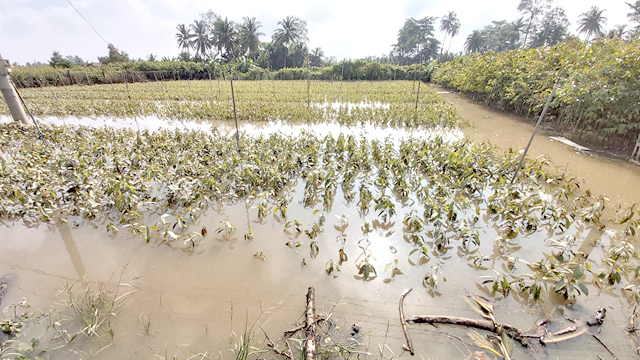 Society
Society

An integrated regional plan on improving infrastructure to attract investment and tackle climate change will be key to “inclusive growth and sustainable development” in the Mekong Delta region, Deputy Minister of Planning and Investment Trần Quốc Phương said at a meeting last week in Cần Thơ.

|
| High tides broke embankments in Bến Tre Province’s Chợ Lách District in mid-November, inundating seedling growing areas. — VNA/VNS Photo Thu Hiền |
HCM CITY — An integrated regional plan on improving infrastructure to attract investment and tackle climate change will be key to “inclusive growth and sustainable development” in the Mekong Delta region, Deputy Minister of Planning and Investment Trần Quốc Phương said at a meeting late last week in Cần Thơ.
Speaking at the seminar on regional development in the 2021-2030 period, Phương said the master plan must focus on people, narrow the development gap between various localities, ensure social security, and reduce poverty.
The delta region, which spreads over 40,577sq.km and is possibly one of the world’s lowest lying deltas, has been Việt Nam’s rice bowl and aquaculture hub for years.
“As the country’s largest agricultural production centre, the delta holds a strategic position within national socio-economic development and defence and security.”
The region, however, faces critical hurdles such as rising sea levels, coastal and riverbank erosion, pollution, ecological imbalance, land subsidence, and flooding in urban areas.
The region should include an emergency response to climate change in its integrated regional plan because rising seas, coastal erosion and subsidence could occur earlier than previously assumed, experts have said.
A comprehensive and scientific evaluation of all factors that could affect the development of the delta region must be completed as well.
The regional plan by 2030 should aim to reduce the negative impact caused by upstream activities and take strong measures to end the overexploitation of sand and groundwater, they said.
It should fully tap the potential of aquaculture and agricultural production, as well as waterway transport, which would contribute to food security nationally and internationally.
Dr Đoàn Hà Phong, of the Institute of Meteorology, Hydrology and Climate Change under the Ministry of Natural Resources and Environment, said the region needs to map out information, data and subsidence for the whole region by building a system to monitor changes in areas at a high risk of subsidence.
Public investment
Localities in the region have been urged to lay out their objectives and priorities for public investment from 2021-2030 to ensure “focused and effective investment” in the region.
They must develop transport infrastructure by diversifying the sources of capital over the next decade, Phương said. Strict management and control of public investment is also needed to minimise losses to the government budget.
Lâm Hoàng Nghiệp, Vice Chairman of Sóc Trăng Province People’s Committee, said the Trần Đề deep water seaport in the province should be included in the master plan for the region. “The large scale national deep-water seaport should use private investment instead of Government’s funding.”
He also recommended adding a project to build coastal roads connecting the coastal provinces of Trà Vinh, Sóc Trăng, Bạc Liêu, and Cà Mau to promote marine economic development.
The Mekong Delta region is expected to be able to take advantage of global investment flows by 2025, attracting large-scale and hi-tech investment to create value chains.
It aims to achieve higher per capita income and more application of high-tech farming, which will account for a larger proportion of the region’s economy.
In 2017, the Government issued a resolution on sustainable development in the region, in which it asked the Ministry of Planning and Investment to work with localities to develop a regional plan by 2030 with a vision to 2050.
The regional plan is in the stage of collecting comments from ministries and localities. It is set to report to the appraisal council in December and will be submitted to the Prime Minister for approval by the end of the year, according to Phương.
The Mekong Delta is the southernmost area of Việt Nam. It includes the centrally-run city Cần Thơ and 12 provinces, accounting for 12 per cent of the country’s area and nearly 20 per cent of the population.
International studies in recent years have warned that the delta is sinking and might disappear within less than a century. But the most recent studies show that it could disappear sooner than previously thought.
Climate Central, a US-based non-profit news organisation that reports on climate science, last year revealed a shocking finding which said that most of southern Việt Nam, including the Mekong Delta, could be seriously flooded by 2050.
The study said that sea levels projected by 2050 could be high enough to force 150 million people permanently below the high tide line. This is three times the number of people than previously estimated. — VNS




